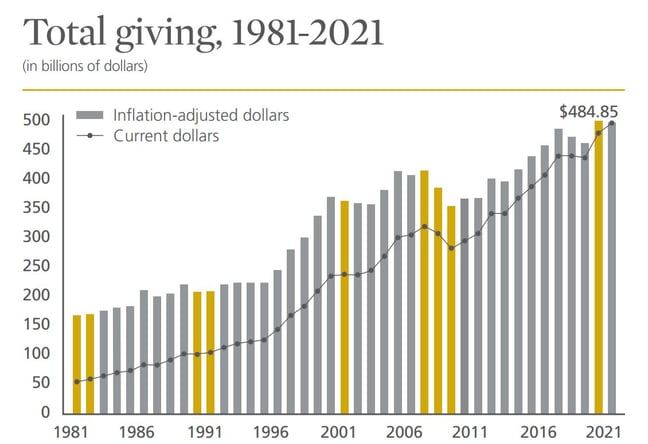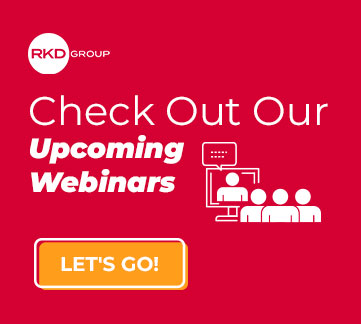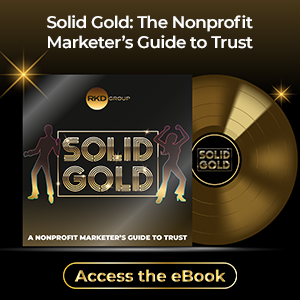Ever since COVID-19 became a national emergency in March of 2020, two words have continually been used to describe the impact of the coronavirus pandemic: unprecedented and uncertain.
However, when it came to the economic impact of the pandemic, these two adjectives didn’t work quite as well. That’s because we’ve seen economic downturns before, and we know how they’ve affected nonprofit organizations.
If you're reading this today, you're likely concerned about the impact that an upcoming recession or depression might have on your nonprofit organization's fundraising results. It’s important to note that this is no time to fear what lies ahead. It’s time to buckle up and prepare for the long road of fundraising during an economic downturn.
What we can expect next
Fortunately, we have precedents and guidance when it comes to this area. We know what happened after 9/11, during the Great Recession and in the COVID-19 pandemic. This gives us a good indication of what nonprofit organizations can expect during times of economic hardship.
- We can expect charitable giving to decline. The way donors responded during the pandemic was nothing short of inspiring. We saw record-breaking donations as people stepped up during a time of tremendous need. We’ve seen surges like this happen before during major disasters and emergencies, but this “bump” in giving is typically followed by a “slump.” This shortfall period is barely noticeable initially, but it adds up over a long period of time.
- Charitable giving will eventually come back. As you can see in the chart below, when there’s a drop due to a recession, a recovery always follows. It may take a bit of time, but we know it will come back. That’s why it’s so crucial to prepare now for what’s to come.

- Some organizations will lose ground; others will gain. In previous recessions, nonprofits who cut their fundraising efforts lost market share in their particular area. When one organization pulls back, donors will turn to another organization to fill their need to give. Click here to read more about research into past recessions.
Thus, our message is to keep fundraising—it’s not insensitive to ask at this time. Don’t assume donors can’t or won’t give. They still care deeply about your mission, and that mission is still important during times of struggle.
The key to success is to prepare for an economic downturn by optimizing your fundraising program. The nonprofits who come out of this ahead will be the ones that implemented changes that made them stand out among the rest.
Donors will likely reduce the number of nonprofits they support, maybe from 10 organizations to only five. You need to stay the course to make sure you’re in their top five.
Our experience tells us there are two foundational areas nonprofits need to shore up now: data and relationships.
Prioritize your data ... and use it
If ever there was a time to get your data house in order, it’s now.
Whether it’s digital, mail, events, planned giving and much more, you need to have a 360-degree view of your donors. Knowing how your donors consume information and how they give will provide the insight you need to accurately plan strategies and budgets. You don’t want to cut funding to a program without seeing how it affects another area.
A few areas you should be leveraging include:
- Email platform
- Google Analytics
- Digital attribution
- Omnichannel CRM data
- Omnichannel campaign results
Insights into these areas will allow you to understand donor behavior and make informed decisions. Without accurate data, you’re forced to make assumptions on what you think you know about your donors. And you’ll completely miss your blind spots.
It’s time to drop the silos. That starts by storing all your data in one system, or at least a set of systems that act as one. Then, you need to find the right tool to analyze all that data and provide useful insights. At RKD, we use a tool called the Donor Marketing Cloud (DMC).

This segmentation allows you to optimize the donor journey by making it personalized and meaningful.
For example, you can provide the content donors want to see (based on their behavior) and create personalized gift arrays (based on their giving history). After the gift, you can send a meaningful thank you that acknowledges the donor personally (based on giving channel and habits).
We see this frequently in consumer retail, where customers have come to expect brands to know what they like and what they want. It should be no different in the charitable giving realm. Donors expect nonprofits to know their interests and their history of giving.
Nothing says “We don’t know you” faster than starting with “Dear Friend.” That’s why prioritizing data is the key to segmentation and personalization.
Think relational, not transactional
Donors want to feel valued and included. How do we know this? They told us so in recent research that we commissioned.
The proper use of data leads to better engagement with donors, which builds a stronger relationship with donors.
Charitable giving is built on relationships, emotions and problem-solving. You need a strong connection with someone to convince them to give their hard-earned money to your cause. Instead of getting a product in return for their money, the donor is getting a good feeling for giving a gift that will make a difference.
But nonprofits have a limit to their relationship-building capacity. Clearly, you can’t build one-on-one relationships with thousands of donors. But you can make your mass communication feel more personal and relational.
For mass-market, direct-response donors, you can utilize the tools of segmentation and personalization discussed above to provide a meaningful relationship through automation. But once a donor moves up the gift pyramid to mid-level, it’s time to get significantly more relational. These donors feel like they know your organization, and they expect you to know who they are.
Data is still key here to understanding who these mid-level donors are and when they provide a gift. You need to track these donors with weekly, monthly and quarterly reports across all channels to get a holistic view of their behavior.
Your current system may tell you a donor gives $200 annually through direct mail, but you may not see her $5,000 table sponsorship at your event, or the fact that she participated in a walk with eight of her friends. A single-channel view shows a $200 donor. A holistic view sees a $5,200 donor who is dedicated to your cause.
The important part is what happens next. And this is where you can make changes right away.
Once you have clear visibility as to who these donors are, work on shoring up your relationships:
- Check in on them by phone or in person periodically
- Provide opportunities to engage with town halls or Q&A sessions
- Offer the chance to speak with an important person in your organization
The goal here is cultivation—creating a dialogue and building these relationships. Build an organization around people, not transactions. A strong relationship can lead to a major gift or a contribution from a donor-advised fund (DAF).
Lastly, don’t forget to tap into your major donors for help during times of need.
We live in the age of influencers. Call upon your major donors to activate their networks. Encourage them to be a part of the giving process and bring in more people to help.
Lean into this group of committed donors, and they will feel great about how much they actually helped your mission.
The road ahead
When an economic downturn is on the horizon, we know the coming months will be challenging. Our message is not to fear the road ahead, but to focus as you approach it.
Start preparing now by shoring up your data and your relationships. In the long run, you’ll emerge as a stronger organization that’s set up for success.






Leave a comment: